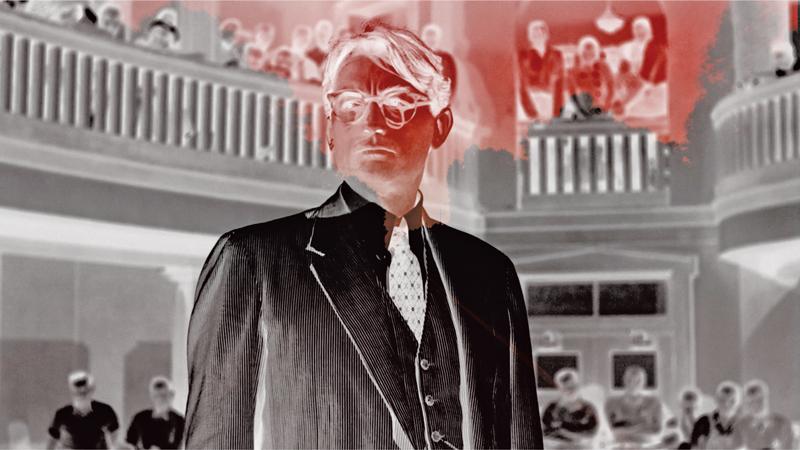The concept of tradition seems inescapable in today’s world. How important is it? How much should we stick to it? Whose definition of it are we using, exactly, and how much room is there for new definitions? Coming just a year into an administration that promised to make our country “great again,” three outstanding feature films at this year’s Ann Arbor Film Festival grapple with the idea of tradition in striking ways–some revering it, some indicting it.
For Ann Arborites, the most recognizable tradition on display among this year’s films is in The Big House, which closely observes the countless rituals surrounding a game day at Michigan Stadium. U-M professors Markus Nornes and Terri Sarris and visiting professor Kazuhiro Soda co-directed the film with the cooperation of the Michigan athletic department and took full advantage of their privileges to roam every nook and cranny of the stadium. They capture kitchen staff preparing food, cheerleaders and band members practicing on the empty field, journalists in the press box, motorcycle cops looping lazily around the parking lot, evangelists and street performers hustling outside, top-dollar donors in their alumni suites, and–in one particularly amusing sequence–John U. Bacon gregariously making his way to a game, seeming to either personally know or be recognized by practically everyone he passes.
The Big House is not a sports movie–there’s almost no game footage. The filmmakers focus instead on documenting the meticulous clockwork that must turn to make a game happen, from the U-M staffer who sets out the players’ customized mouth guards to the moneyed alums who keep the Big House and the university in business. In an extended sequence late in the movie, the camera roves through the 2016 regents’ and president’s tailgate at Crisler Arena, observing as U-M president Mark Schlissel thanks donors for their contributions.
The film pivots at the end to scenes of protests (and counter-protesting agitation) outside the Big House and in the streets of Ann Arbor in the days following Donald Trump’s election and inauguration. The filmmakers come off as playfully, almost agnostically observant throughout the film, and it doesn’t seem they’re trying to make any particular statement on the power players in Crisler or the political dissidents on the street. But the overall impression they present is of the Big House as a true home for every element of Ann Arbor–even the radical politics that might seem at odds with football culture.
A furious, damning portrait of a far deadlier tradition comes in director Travis Wilkerson’s Did You Wonder Who Fired the Gun? Inspired by George Zimmerman’s acquittal in the shooting of Trayvon Martin, Wilkerson’s film is an investigation into the racial violence in his own family’s history. Wilkerson’s white great-grandfather, S.E. Branch, shot and killed Bill Spann, a black man, in 1946, but any other details of the situation are maddeningly unclear–and they remain so. Wilkerson learns precious little new information about the murder, but he builds fascinating and upsetting context around the crime, ranging from the tale of his white supremacist aunt to family members’ memories of Branch’s numerous other crimes.
Wilkerson shoots most of the movie in stark black and white, with some shots colorized to a sickly blood red. He narrates his own Southern Gothic mystery with seething, barely contained outrage. And, in the end, he’s frustrated to find that history seems to have almost erased the record of Spann, right down to the man’s unmarked grave. Wilkerson draws direct parallels from Spann to the recent killings of black men like Martin, Eric Garner, and Philando Castile. “Give it enough time, and whiteness will incinerate the world,” Wilkerson spits. The least we can do to fight the fire, he suggests, is to ensure names like Spann’s are no longer forgotten.
A strikingly bittersweet meditation on yet another kind of tradition comes in Simon Plouffe’s film Those Who Come, Will Hear, whose subject is the rapidly disappearing indigenous languages of Quebec. Plouffe travels to capture these languages in the wild, interviewing the wizened Quebecois who may be their final practitioners. One elderly woman, who also speaks French and English, laments that her knowledge of indigenous language has dimmed because “I wouldn’t have anyone to talk to anyways.”
As Plouffe makes clear, more is at stake than just a set of spoken or written words. He portrays the deep connection between language and the way people understand their world. A Nehirowisiw man describes not only the word he knows for blueberry–minic–but the connection to nature and the “magical feeling” that comes with picking one. Like Wilkerson, Plouffe embraces the power in calling out words that might otherwise be forgotten, but his intention is to uphold tradition, rather than dismantle it.
Taken together, these three films remind us that tradition is more than just the way we do things–it’s the way we choose to see ourselves and our communities. The battles fought for and against tradition in these films, and those we’re fighting over it now, are all the more vital for that.
The Fifty-Sixth Ann Arbor Film Festival runs March 20-25. The Big House screens March 24 at 1 p.m. in the Michigan Theater main auditorium. Did You Wonder Who Fired the Gun? screens March 24 at 12:30 p.m. in the Michigan Theater screening room. Those Who Come, Will Hear is shown March 23 at 5 p.m. in the Michigan Theater screening room.


